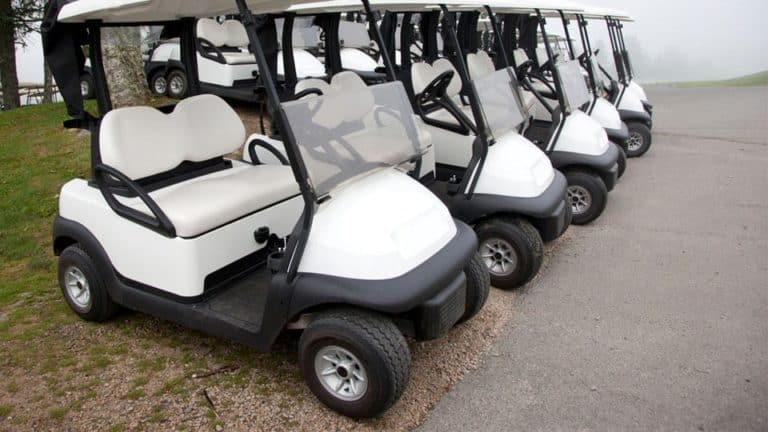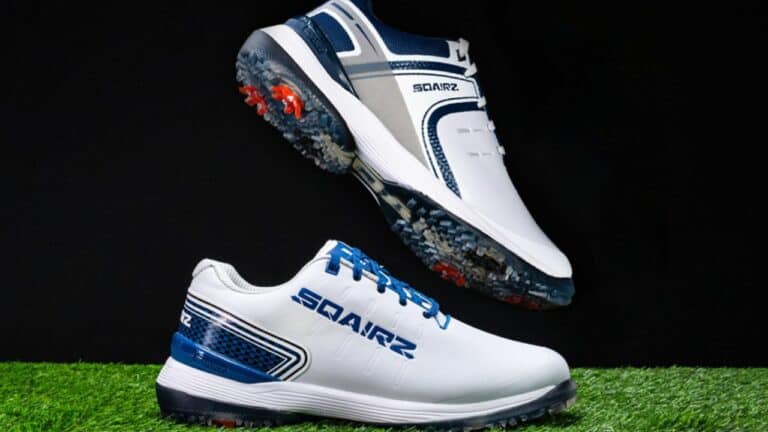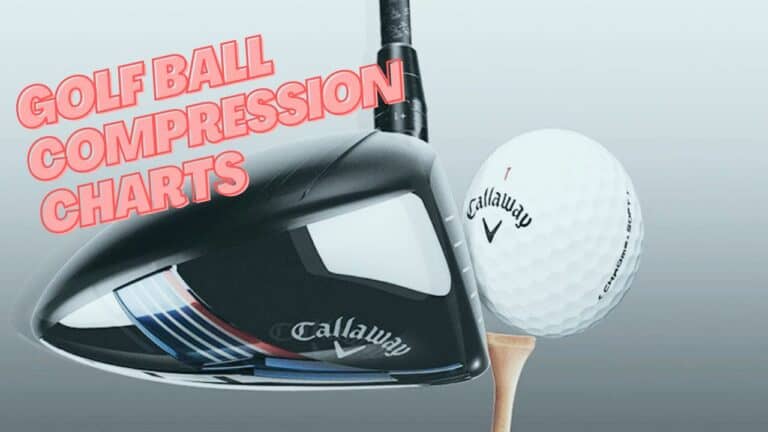How To Chip A Golf Ball Consistently- Pro Tips, Techniques
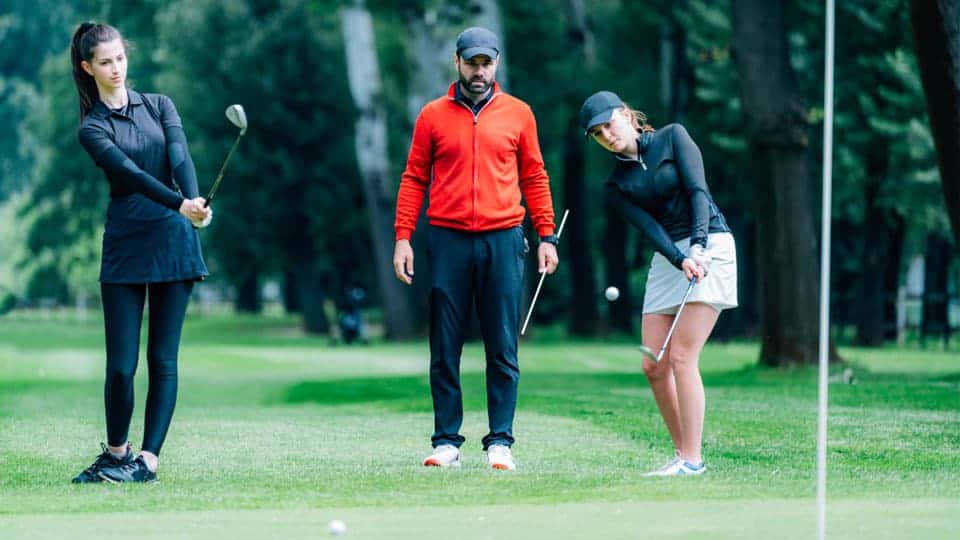
Hitting a successful chip shots requires technique and precision. Read on as we discuss the best way to hit a chip shot and how to avoid common mistakes.
The chip shot is a type of golf swing that drives the ball over a very short distance. The goal is to bring the ball fairly close to the hole. Although it may seem easy, the chip shot is one of the toughest to execute.
Once you know how to improve your chipping, you are all set to lower your score and build your confidence.
Find out more about what a chip shot is, how to chip a golf ball, and a lot more.
What is a chip shot?
A chip shot is a type of shot in the short game of golf, typically played around the green. It is designed to get the ball onto the putting surface and rolling towards the hole.
While chipping, the ball is usually struck with a descending blow, using a combination of backspin and forward roll to control distance and accuracy.
Main aim of chipping
The chip shot is a type of golf swing that drives the ball over a very short distance. The goal is to get the ball fairly close to the hole. Although it may seem easy, the chip shot is one of the toughest to execute.
Usually, the situations on the golf course that need a chip shot are:
- When the green is very close to the hole, with at least 15 feet between the edge of the green and the hole.
- The ball is within five yards of the green, and there isn’t any sand or significant curvature to play over. There’s at least 20 feet of grass to work with, and it’s not hard.
How to chip in golf: Basic techniques
Chipping is generally considered to be an easier shot than a full swing, but it still requires practice and precision.
Follow these 3 simple steps below to have a good understanding of the golf chipping techniques.
Step 1 – Set Up
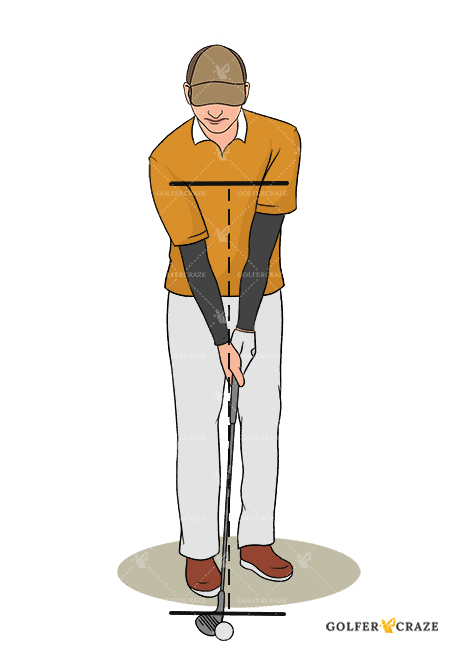
- Stand with feet shoulder-width apart, weight centered.
- Align the clubface with the target.
- Grip the club lightly with both hands.
Step 2 – Chipping Swing
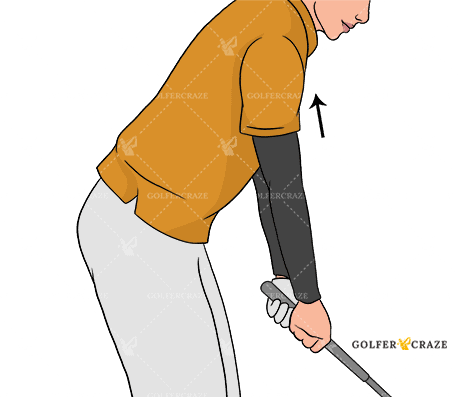
- Keep the hands low and arms relaxed.
- Swing the club back and forth in a pendulum motion.
- Make contact with the ball and follow through.
Step 3 – Follow-Through
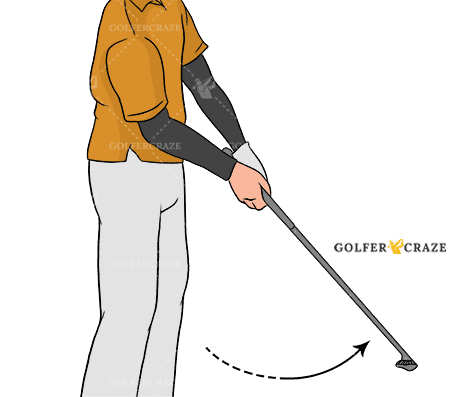
- After making the contact, complete the follow-through movement.
- Finish with the clubhead pointing in the direction of the shot.
- Evaluate the shot and adjust for the next one.
Hinge and hold method: Phil Mickelson chipping technique
The hinge and hold method is the easiest way to get more control over your chip shots. It was a term coined by Phil Mickelson (Pro Golfer). This technique involves hinging your wrists on the backswing and then holding the position at the top of the swing. This will help you to keep the loft on your club and make solid contact with the ball.
To execute this technique:
- Take your normal stance and grip.
- Then, on the backswing, hinge your wrists so that the club points straight up.
- At the top of the swing, hold this position for a moment before striking the ball. This will help you to keep the loft of the clubface in solid contact with the ball. Moreover, this would ultimately end up having a short game.
Note: The common mistake that people make while performing this technique is that they release the golf club right before hitting the ball. This further leads to a change in the loft at impact, which ultimately results in inconsistency and even sometimes to a bladed shot.
Best chipping Golf clubs for the perfect chip shots
When you are on the golf course, your main goal is to hit a short swing in order to get the ball into the hole in as few shots as possible. In order to do this, you need to be precise with your shots and choose the best chipping club for each shot.
For example, shorter irons will produce a higher trajectory and less rollout, while longer irons will produce a lower trajectory and more rollout.
The following are the clubs used for chip shots on a golf course:
- Pitching wedge (ideal for beginners)
- Sand wedge
- Gap wedge
- Lob wedge
- 7-iron
- 8-iron
- 9-iron
- Hybrids
(Note: The lob wedge is more suited to advanced players. These clubs are designed to provide more loft and spin, making it easier to stop the ball close to the hole.)
Chipping with your wedges
There are two techniques you can follow when chipping with your golf wedges:
- Chipping with the leading edge: A chip shot where the leading edge of the clubface contacts the ground evenly, allowing for a controlled and accurate shot
- Chipping using the bounce: A chipping shot where you hit the golf ball with the bottom part of the clubface. This allows the club to glide along the ground.
Chipping: One club vs. many clubs
Chipping can be done with either one club or by choosing from multiple clubs. One club provides you more control and accuracy, while multiple clubs allow for more versatility and distance.
Here is a comparison of the advantages and disadvantages of one club chipping:
| Advantages | Disadvantages |
| Club selection massively simplified | Not easy to predict spin when using wedges |
| Easier to get comfortable with the one club | Easier to hit fat or thin shots when |
| Relatively easy to add and subtract distance by varying length of stroke | Harder to judge roll-out. Especially on long chips |
| Relatively easy to add and take off loft | Hard to control loft |
How to hit 60 degree wedge?
A 60-degree wedge is a high-lofted club that is designed for short shots around the green, such as bunkers and high, soft pitches. Here are some steps to help you hit a 60-degree wedge effectively:
- Stance: Stand close to the ball with your feet shoulder-width apart and aim for an open stance, where your front foot is pointing towards the target.
- Grip: Hold the club firmly but not too tight, and make sure that your hands are ahead of the ball at address.
- Swing: Use a smooth and fluid motion, keeping your eye on the ball throughout the shot. Focus on hitting down on the ball, which will create backspin and help the ball stop quickly once it lands on the green.
- Follow-through: Make sure to complete your follow-through with a relaxed wrist and arm, and avoid decelerating too quickly.
Factors to account for before hitting a chip shot
- Distance to the hole
- Lie of the ball (e.g. rough, fairway, sand)
- Type of shot desired (e.g. high, low, straight shot)
- Wind conditions
- Break (slope) of the green
- Club selection (Recommended chipping wedge: sand wedge, pitching wedge, 9-iron)
- Target line
- Ball position (relative to feet and clubface)
- Stance and posture
- Swing technique (e.g. speed, length, weight shift)
Common golf chipping mistakes
Chip shots are a crucial part of golf’s short game, but even minor errors can have a significant impact on the precision and range of the shot.
1. Keeping Hands Too High
Keeping your hands too high during the chip shot can cause you to hit the ball too high and lose control over the shot’s trajectory. This can result in a shot that flies too far or not far enough.
2. Hitting Ball Off-Center of Clubface
Striking the ball away from the center of the clubface can result in slicing or hooking, leading to a loss of control over the shot and potentially causing it to veer off target or fall short.
3. Improper Weight Transfer
Failing to adequately shift weight during the swing can decrease power and accuracy. This can result in a shot that drops short of the planned distance or misses the intended direction.
4. Failing to Follow Through
Incomplete follow-through in the swing can result in a shorter ball flight, causing the shot to fall short of the target or land before reaching it.
5. Gripping Club Too Tightly
Understand how to hold the golf club. Gripping the club too tightly when chipping can cause the wrists to tense up and make it difficult to smoothly swing. This can result in an inaccurate shot that doesn’t travel far. It can also cause wrist pain or discomfort.
Tips for chipping golf balls
If you want to chip golf balls perfectly, here are some golf chipping tips you should follow:
- Ensure proper posture when chipping, with your weight forward and left shoulder over the left foot.
- Understand the ball-turf interaction. Additionally, the ball position for chipping is extremely important. Ensure that the ball is placed at the center of your stance.
- Use a shorter backswing and focus on keeping your hands low during the swing.
- Keep your wrists firm throughout the swing and use a smooth acceleration on the downswing.
- Focus on distance control – adjust the length of your backswing depending on how far you need to hit the ball.
- Practice chip shot drills regularly to hone your skills – try drills such as the “Y” or Triangle Chipping Drill, The Hula Hoop Chipping Drill, Trail Hand Release Chipping Drill, or Chip-a-Coin Chipping Drill.
- Follow the anti-roll method golf shot. This will help you to keep the ball low and prevent it from rolling too far or curving off course.
Chipping vs pitching
Chipping and pitching are two types of shots in the game of golf. They both require different techniques to execute effectively and are important parts of improving your short game in golf.

Understanding the difference between chipping and pitching, when to use each shot, and what club to use for chipping vs what club to use in pitching, is crucial to success on the course.
| Chipping | Pitching |
| Shot played from close to the green | Shot played from further away from the green |
| Goal is to get the ball up in the air and onto the green quickly | Goal is to get the ball to stop quickly once it lands on the green |
| Typically played with a high-lofted club (sand wedge, lob wedge) | Typically played with a lower-lofted club (gap wedge, pitching wedge) |
| A low-flying shot | A higher-flying shot |
| Requires precision and control | Requires precision and control |
| Purpose: To get the ball rolling as quickly as possible once it lands on the green | Purpose: To get the ball to stop quickly once it lands on the green |
How to chip and make it stop?
To chip and make the ball stop quickly once it lands on the green, follow these steps:
- Select the right club: Choose a club with a lower loft, such as a gap wedge or pitching wedge, to get the ball in the air and onto the green.
- Address the ball: Stand close to the ball and make a compact, crisp swing.
- Weight distribution: Shift your weight slightly forward during the swing, with most of your weight on your front foot.
- Hands and grip: Hold the club lightly and position your hands ahead of the ball to create a descending blow.
- Swing: Make a smooth and steady swing, keeping your eye on the ball throughout the shot. Focus on hitting the back of the ball and following through with your swing.
- Land the ball: Aim for a spot on the green that is just beyond the hole and allow the ball to roll out. The ball should release and roll towards the hole with backspin.
Why do I shank chip shots?
Shanking chip shots is a common issue for golfers and can be caused by several factors, including:
- Poor grip
- Incorrect clubface alignment
- Improper swing path
- Incorrect stance and posture
- Using the wrong club for the shot
What is the rule of 12 in chipping?
The Rule of 12 is a simple guide for golfers to help determine how much their ball will roll on the green when landing. By dividing the height of the green (in inches) by 12, golfers can estimate the distance the ball will roll after it lands.
This estimations helps them select the right club, adjust power, and predict where the ball should come to rest. While it is not always exact, this rule can be a useful tool in improving chipping and short game play.
Conclusion
In conclusion, chipping a golf ball is a technique that every golfer should learn in order to lower their score. There are different ways to chip a golf ball, and it is important to choose the right technique depending on the situation.
Remember to avoid common errors that can hamper your success, maintain a light grip on the club, and select the right club for each shot. By following the tips in this article, you can improve your game and start scoring lower than ever before.



